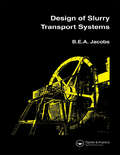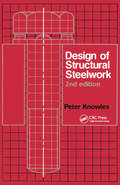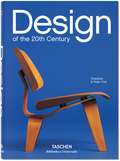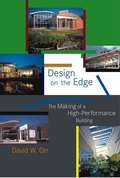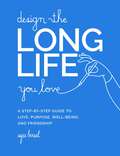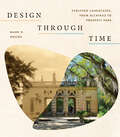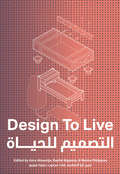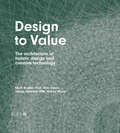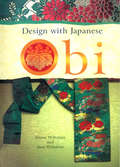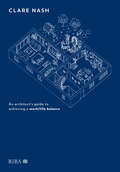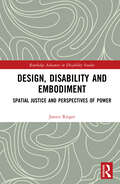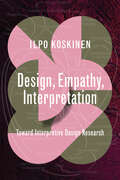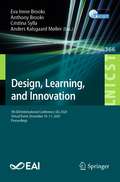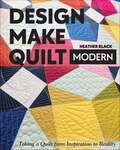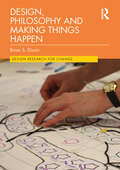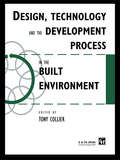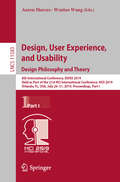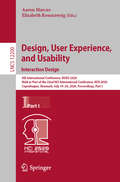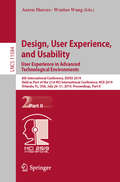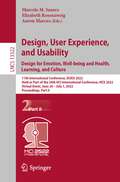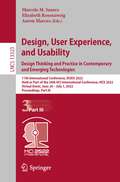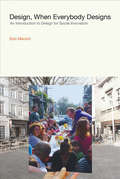- Table View
- List View
Design of Slurry Transport Systems
by B.E.A. JacobsThis book benefits users, manufacturers and engineers by drawing together an overall view of the technology. It attempts to give the reader an appreciation of the extent to which slurry transport is presently employed, the theoretical basis for pipeline design, the practicalities of design and new developments.
Design of Structural Steelwork
by P.R. KnowlesThis second edition of Design of Structural Steelwork presents the essential design aspects of steel as a structural material. It has been carefully revised and updated to provide a modern introduction to the subject, assuming only a basic knowledge of structural analysis and solid mechanics.
Design of the 20th Century
by Fiell Charlotte Peter FiellThe bible of 20th-century design: From Art Nouveau to minimalism and everything in between Poised at the start of the 21st century, we can see clearly that the previous century was marked by momentous changes in the field of design. Aesthetics entered into everyday life with often staggering results. Our homes and workplaces turned into veritable galleries of style and innovation. From furniture to graphics, it`s all here - the work of artists who have shaped and recreated the modern world with a dizzying variety of materials. From the organic to the geometric, from Art Deco, through to Pop and High-Tech, this book contains all the great names - Harry Bertoia, De Stijl, Dieter Rams, Philippe Starck, Charles and Ray Eames, to name only a very few. This essential book is a comprehensive journey through the shapes and colors, forms and functions of design history in the 20th century. An A-Z of designers and design schools, which builds into a complete picture of contemporary living. Lavishly illustrated, this is design in the fullest sense. About the Series: Bibliotheca Universalis -- Compact cultural companions celebrating the eclectic TASCHEN universe at an unbeatable, democratic price! Since we started our work as cultural archaeologists in 1980, the name TASCHEN has become synonymous with accessible, open-minded publishing. Bibliotheca Universalis brings together nearly 100 of our all-time favorite titles in a neat new format so you can curate your own affordable library of art, anthropology, and aphrodisia. Bookworm's delight -- never bore, always excite!
Design the Home You Love: Practical Styling Advice to Make the Most of Your Space [An Interior Design Book]
by Lee Mayer Emily MotayedFrom the co-founders of Havenly comes &“a perfect read for anyone looking to infuse more personality and style into their space—on their own time and budget, and in their own unique way&” (Rachel Zoe). &“Not only do Lee and Emily unpack all their tips for creating a space that looks as good as it feels, but they do it in a way that is made for real-life application.&”—Bobby Berk, design expert and host of Netflix&’s Queer Eye Interior design can be daunting, and as a result, many of us never even attempt to design our own homes. In Design the Home You Love, Havenly founders Lee Mayer and Emily Motayed break down the ambiguous world of home design. First you learn how to identify your own style (whether you&’re a fan of Parisian Modern or California Casual) and then how to incorporate furniture that matches your style and fits your budget. Design the Home You Love takes you step-by-step and room-by-room through each part of the house to help you fulfill your home&’s potential. Whether you&’re looking to give your home a complete makeover, spruce up your rental apartment, or merely take your living room from blah to fab, Lee and Emily bring fresh ideas, advice, and inspiration to the table. Illustrated with eye-catching photography and livable inspiration from real-life clients, this is the interior design book that finally makes it possible for us all to achieve our design goals.
Design the Long Life You Love: A Step-by-Step Guide to Love, Purpose, Well-Being, and Friendship
by Ayse BirselDesign a long life full of love, purpose, well-being, and friendship, at any age, using the creative tools of award-winning product designer, author, and world's #1 life coach Ayse Birsel.What does it mean to craft the life you want, as you grow older? For industrial designer and author Ayse Birsel, the answer draws on key principles of design—like optimism, empathy, collaboration, open-mindedness, and holistic thinking—as well as the experiences of older people on the pioneering frontiers of long life. Longer life is a thrilling, modern opportunity, and like so many parts of life it needs to be thoughtfully designed. Thinking about a long life is very exciting indeed. It&’s also a new phenomenon. Fifty years ago, living into one&’s seventies was considered the mark of a long life. Today, seventy feels young, eighty feels normal, and ninety is within reach. Birsel believes this new horizon of life is as important and exciting as the invention of moving pictures. Or that of automobiles, or even space travel. Her point is, when a change this big happens, innovation follows.This book is for everyone who is interested in defining their long life, using design thinking tools. It&’s an interactive book with exercises that will help you think creatively by asking you to visualize your life. It is full of insights learned from wise people who have lived the longest. It is organized into the four themes of Love, Purpose, Well-Being, and Friendship, and contains insights that will help you love better, find purpose, practice well-being, and make friends. Drawing on Birsel&’s year-long codesign research with older people, Design the Long Life You Love offers readers of all ages—from those in their twenties and thirties just starting out, to those in mid-life looking for a change, to those in later life who are the experts for us all—thought-provoking questions, exercises for self-exploration, and interviews with innovative entrepreneurs and thought-leaders to guide them on their own journeys of crafting the next phase of life. Focusing on four keys areas—Love, Purpose, Well-Being, and Friendship—this book pairs life lessons from people who've lived the longest with design tools to help you plan your own long life, whether you're looking ahead to retirement, a home post-children, or starting a new project that makes you come alive.Playfulness is key to creating a long life, and readers will find that reflected in this joy-filled book. Whimsical, two-color drawings, illustrated interviews with thought-leaders, and interactive exercises will put you in the mindset of a designer as you foster creativity and explore what your own long life can look like. When it comes to our lives, we are our own innovators—so let's begin to learn how to do just that.Welcome to Design the Long Life You Love!
Design through Time: Evolving Landscapes, from Alcatraz to Prospect Park
by Mark H. HoughUnderstanding landscape design as a dynamic, not static, art form Landscape architects do not situate their work in a vacuum. It exists in a state of constant change and is better understood as a product of continual evolution than as a work of pure design. In Design through Time, Mark Hough offers case studies of parks, gardens, campuses, communities, and cultural sites—from the Missouri Botanical Garden and Mount Auburn Cemetery to Tuskegee University and Dumbarton Oaks Park—to answer several crucial questions: Who is the proposed landscape conceived to please? How will it change, affected by both natural and societal events? How will stewards address the need for landscapes to remain relevant, attractive, and accessible? To address these concerns, Hough analyzes the influence and impact of generations of administrators, advocates, horticulturalists, institutional leaders, elected officials, and others whose collective decisions compel landscapes to grow and change in ways that strive to respect their established legacies while adjusting to shifting cultural, ecological, and economic realities. The resulting work is a dynamic look at landscape design that reflects its status as an art form that is ever changing, never static.
Design to Live: Everyday Inventions from a Refugee Camp
by Azra Aksamija Raafat Majzoub Melina PhilippouThe power of design to create a life worth living even in a refugee camp: designs, inventions, and artworks from the Azraq Refugee Camp in Jordan.This book shows how, even in the most difficult conditions--forced displacement, trauma, and struggle--design can help create a life worth living. Design to Live documents designs, inventions, and artworks created by Syrian refugees living in the Azraq Refugee Camp in Jordan. Through these ingenious and creative innovations--including the vertical garden, an arrangement necessitated by regulations that forbid planting in the ground; a front hall, fashioned to protect privacy; a baby swing made from recycled desks; and a chess set carved from a broomstick--refugees defy the material scarcity, unforgiving desert climate, and cultural isolation of the camp. Written in close collaboration with the residents of the camp, with text in both English and Arabic, Design to Live, reflects two perspectives on the camp: people living and working in Azraq and designers reflecting on humanitarian architecture within the broader field of socially engaged art and design. Architectural drawings, illustrations, photographs, narratives, and stories offer vivid testimony to the imaginative and artful ways that residents alter and reconstruct the standardized humanitarian design of the camp--and provide models that can be replicated elsewhere. The book is the product of a three-year project undertaken by MIT Future Heritage Lab, researchers and students with Syrian refugees at the Azraq Refugee Camp, CARE, Jordan, and the German-Jordanian University. Copublication with Future Heritage Lab, MIT
Design to Value: The architecture of holistic design and creative technology
by Martin Wood John Dyson Mark Bryden Jaimie JohnstonWhat opportunities does Design to Value afford the built environment? Design to Value is a commitment to process above all else. Well understood and applied in the manufacturing industries, its potential is only now starting to be realised in architecture, engineering and construction. It challenges designers to lead the way in creating more innovative and stakeholder-centric analyses, workflows, construction techniques and products. Through architectural thinking, value in the built environment can be maximised. Seeking to create deep and lasting impacts on industry, society and the planet, Design to Value rejects architecture’s current professional services model. The design and delivery stages of traditional procurement routes are not sustainable, and Design to Value outlines a new path for informed design processes. Bryden Wood, leading international expert in Modern Methods of Construction (MMC) and the Platform approach to Design for Manufacture and Assembly (P-DfMA), has spent the last fifteen years developing Design to Value as part of a new framework for the future of the design and construction industry. In this essential book, the practice challenges architects and the wider industry to think differently about how value is generated, enhanced and retained in the built realm, providing a method that will improve outcomes for architects, clients, industries and society. Architects must bend and break habitual processes to build better systems, better buildings and better futures. Features: Over 125 images, including photographs, sketches and diagrams Over 20 international case studies, including those from Canada, France, India, Italy, Japan, Saudi Arabia and USA Projects from leading practices, such as Atelier Bow-Wow, BIG, David Miller Architects, Kieran Timberlake and Lacaton & Vassal, as well as Bryden Wood.
Design with Japanese Obi
by Diane Wiltshire Ann WiltshireIn Design with Japanese Obi, the authors present the obi as it is being used in interiors today, demonstrating simple yet striking techniques for makingthese exquisite kimono sashes the centerpiece of any room's decor. The focus is on seven key uses for obi that are applicable to nearly any setting imaginable, such as: Artistic table arrangements Dining room accents Framing enhancements Fabric coveringsThese and other dramatic and innovative uses of obi in interior design are presented along with such essentials as color coordination, fabric shaping, and accessories for hanging obi. The vivid photographs in this book present some of the most elegant interiors the authors have found, from Tokyo to Washington, D.C., and show the obi being used in today's homes to create a sumptuous, refined, and modern ambiance.
Design your life: An architect’s guide to achieving a work/life balance
by Clare NashTen years ago, Clare Nash was struggling with a common problem: how to be an architect and still have a life. With no job, no savings and no clients in the midst of a recession, Clare set up her own practice with little more than a few postcards in local shop windows and a very simple website. Determined to better combine her life and family with professional work, she created an innovative practice that is flexible and forward-looking, based around remote working and the possibilities offered by improving technology. Bursting with tips, ideas and how-tos on all aspects of designing a working life that suits you and your business, this book explains in clear and accessible language how to avoid the common pitfalls of long hours and low pay. It explores how to juggle work with family commitments, how to set your own career path and design priorities, and how to instil a flexible working culture within a busy lifestyle. Encompasses the full range of life-work challenges: Money, fees and cashflow Playing to your personal strengths Outsourcing areas of weakness Building a happy and productive remote-working team Creating a compelling marketing strategy Juggling parenthood and work Studying and honing workplace skills Provides the inside view from innovative practices: alma-nac, Gbolade Design Studio, Harrison Stringfellow Architects, Invisible Studio Architects, Office S&M Architects, POoR Collective, Pride Road Architects and Transition by Design.
Design, Disability and Embodiment: Spatial Justice and Perspectives of Power (Routledge Advances in Disability Studies)
by Janice RiegerThis timely book explores the spatial and social injustices within our streets, malls, schools, and public institutions. Taken-for-granted acts like going for a walk, seeing an exhibition with a friend, and going to school are, for people with disabilities, conditional or precluded acts due to exclusion by design. This book stimulates debate and discussion about current practice and studies in spatial design in the context of disability and the growing need for inclusive design globally. Case studies of inclusive design in spaces like museums, malls, galleries and universities are presented to challenge and expose the perspectives of power and spatial injustices that still exist within these spaces today. The international case studies presented purposely privilege the voices and perspectives of people with disabilities, to expose the multisensorial perspectives of spatial justice in order to understand inclusion more holistically through embodiment. If you are an architect, designer, arts educator, curator or museum professional or just want a world where spatial justice is possible, then this book will provide you with a new perspective of spatial design through critical disability studies, allyship and codesign, where tangible approaches and practices for inclusive design are explored.
Design, Displacement, Migration: Spatial and Material Histories (Routledge Research in Design History)
by Sarah A. LichtmanDesign, Displacement, Migration: Spatial and Material Histories gathers a collection of scholarly and creative voices—spanning design, art, and architectural history; design studies; curation; poetry; activism; and social sciences––to interrogate the intersections of design and displacement. The contributors foreground objects, spaces, visual, and material practices and consider design’s role in the empire, the state, and various colonizing regimes in controlling the mass movement of people, things, and ideas across borders, as well as in social acts that resist forced mobility and immobility, or enact new possibilities. By consciously surfacing echoes, rhymes, and dissonances among varied histories, this volume highlights local specificity while also accounting for the vectors of displacement and design across borders and histories. Design, Displacement, Migration: Spatial and Material Histories shows displacement to be a lens for understanding space and materiality and vice versa, particularly within the context of modernity and colonialism. This book will be of interest to scholars working in design history, design studies, architectural history, art history, urban studies, and migration studies.
Design, Empathy, Interpretation: Toward Interpretive Design Research (Design Thinking, Design Theory)
by Ilpo KoskinenA new, empathic approach to design research, drawn from the informed experiences of a leading design research program in Finland.Design, Empathy, Interpretation tells the story of empathic design, a design research program at Aalto University in Helsinki, Finland, that has developed an interpretive approach to design over the past twenty years. As one of the leaders of the Helsinki group, Ilpo Koskinen draws on his own experiences to offer readers a general intellectual and professional history of design research, and argues for what he calls an interpretive approach. Design, Empathy, Interpretation shows how the group has created connections all across the globe, and how a seemingly soft approach to design research can be useful in both industry and government.Koskinen follows design research&’s transformation from questions of usability, in the 1980s, through to the revolution in personal electronics and the &“user-centered&” turn of the 1990s. Using the research community in Helsinki as a case study, and moving between specific projects and theoretical debates, he offers readers a focused introduction to the major methodological and intellectual challenges—as well as the opportunities—of design research. He argues that all design tasks, however simple or complex, begin with understanding the way humans ascribe meaning, both as individuals and as actors in complex societies. Thus all design research must be interpretive at its core.A new, empathic approach to design research, drawn from the informed experiences of a leading design research program in Finland.
Design, Learning, and Innovation: 5th EAI International Conference, DLI 2020, Virtual Event, December 10-11, 2020, Proceedings (Lecture Notes of the Institute for Computer Sciences, Social Informatics and Telecommunications Engineering #366)
by Cristina Sylla Anthony Brooks Eva Irene Brooks Anders Kalsgaard MøllerThis book constitutes the refereed post-conference proceedings the 5th EAI International Conference on DLI 2020, Design, Leaning and Innovation, which took place in December 2020. Due to COVID-19 pandemic the conference was held virtually. The 14 revised full papers presented were carefully selected from 40 submissions and are organized in four thematic sessions on: digital technologies and learning; designing for innovation; digital games, gamification and robots; designs for innovative learning.
Design, Make, Quilt Modern: Taking a Quilt from Inspiration to Reality
by Heather BlackFrom concept to completion—the modern quilter’s design guide Create a quilt that is uniquely yours! Award-winning quilter Heather Black demystifies the design process with easy-to-understand tips and basic quilt math for modern makers. Learn to spot and jot down ideas from everyday life, sketching your quilt inspirations on simple graph paper. Take your quilt designs from ordinary to energetic with practical advice to create movement and depth. Achieve color balance, choose the right fabrics to pull off your pattern, and add custom quilting to elevate the impact of your quilt. Whether this is your first time to strike out on your own or you’ve made quilts from scratch before, this book will help you identify your likes and dislikes and freshen your approach to modern quilt design. Also included are three modern quilts with full-size patterns that you can take straight to the sewing machine! Choose colors and fabrics like a pro, with solid design and finishing advice Tailor the process to your interests and skills with piecing, applique, and hand or machine sewing Sew 3 bonus full-size patterns from celebrated quiltmaker Heather Black
Design, Philosophy and Making Things Happen (Design Research for Change)
by Brian S. DixonDrawing from the work of Dewey, Wittgenstein and Heidegger, this book aims to relate a series of philosophic insights to the practice of engaging in design research for change. These insights are explored and presented as a set of potential strategies for grounding transformative design research within an intellectual context which both embraces and celebrates experience, process and uncertainty. Chapter by chapter, through theory, practical examples and case studies, an accessible narrative opens up around the coupled themes of existence and experience, language and meaning and knowing and truth. The outcome is a rich and detailed perspective on the ways in which philosophy may afford design research for change a means to both explain, as well as understand, not only what it is and what it does, but also what it could be. The book will be of interest to scholars working in design studies, design theory and design research.
Design, Technology and the Development Process in the Built Environment (Built Environment Series Of Textbooks Ser.)
by Tom CollierThis second book in the BEST series explores the fundamental generators and contextual issues - philosophical, physical and political - that influence built environments. It draws on international examples to show how societies and cultures in different parts of the world react to similar problems. It contrasts dramatically different types of buildings and enclosures from primitive shelters to space laboratories. They show how mankind endeavours to control the environment - whatever it is.
Design, User Experience, and Usability. Design Philosophy and Theory: 8th International Conference, DUXU 2019, Held as Part of the 21st HCI International Conference, HCII 2019, Orlando, FL, USA, July 26–31, 2019, Proceedings, Part I (Lecture Notes in Computer Science #11583)
by Aaron Marcus Wentao WangThe four-volume set LNCS 11583, 11584, 11585, and 11586 constitutes the proceedings of the 8th International Conference on Design, User Experience, and Usability, DUXU 2019, held as part of the 21st International Conference, HCI International 2019, which took place in Orlando, FL, USA, in July 2019.The total of 1274 papers and 209 posters included in the 35 HCII 2019 proceedings volumes was carefully reviewed and selected from 5029 submissions.DUXU 2019 includes a total of 167 regular papers, organized in the following topical sections: design philosophy; design theories, methods, and tools; user requirements, preferences emotions and personality; visual DUXU; DUXU for novel interaction techniques and devices; DUXU and robots; DUXU for AI and AI for DUXU; dialogue, narrative, storytelling; DUXU for automated driving, transport, sustainability and smart cities; DUXU for cultural heritage; DUXU for well-being; DUXU for learning; user experience evaluation methods and tools; DUXU practice; DUXU case studies.
Design, User Experience, and Usability. Interaction Design: 9th International Conference, DUXU 2020, Held as Part of the 22nd HCI International Conference, HCII 2020, Copenhagen, Denmark, July 19–24, 2020, Proceedings, Part I (Lecture Notes in Computer Science #12200)
by Aaron Marcus Elizabeth RosenzweigThis book constitutes the refereed proceedings of the 9th International Conference on Design, User Experience, and Usability, DUXU 2020, held as part of the 22nd International Conference on Human-Computer Interaction, HCII 2020, in Copenhagen, Denmark, in July 2020. The conference was held virtually due to the COVID-19 pandemic.From a total of 6326 submissions, a total of 1439 papers and 238 posters has been accepted for publication in the HCII 2020 proceedings. The 40 papers included in this volume were organized in topical sections on UX design methods, tools and guidelines, interaction design and information visualization, and emotional design.
Design, User Experience, and Usability. User Experience in Advanced Technological Environments: 8th International Conference, DUXU 2019, Held as Part of the 21st HCI International Conference, HCII 2019, Orlando, FL, USA, July 26–31, 2019, Proceedings, Part II (Lecture Notes in Computer Science #11584)
by Aaron Marcus Wentao WangThe four-volume set LNCS 11583, 11584, 11585, and 11586 constitutes the proceedings of the 8th International Conference on Design, User Experience, and Usability, DUXU 2019, held as part of the 21st International Conference, HCI International 2019, which took place in Orlando, FL, USA, in July 2019.The total of 1274 papers and 209 posters included in the 35 HCII 2019 proceedings volumes was carefully reviewed and selected from 5029 submissions.DUXU 2019 includes a total of 167 regular papers, organized in the following topical sections: design philosophy; design theories, methods, and tools; user requirements, preferences emotions and personality; visual DUXU; DUXU for novel interaction techniques and devices; DUXU and robots; DUXU for AI and AI for DUXU; dialogue, narrative, storytelling; DUXU for automated driving, transport, sustainability and smart cities; DUXU for cultural heritage; DUXU for well-being; DUXU for learning; user experience evaluation methods and tools; DUXU practice; DUXU case studies.
Design, User Experience, and Usability: 11th International Conference, DUXU 2022, Held as Part of the 24th HCI International Conference, HCII 2022, Virtual Event, June 26 – July 1, 2022, Proceedings, Part II (Lecture Notes in Computer Science #13322)
by Aaron Marcus Marcelo M. Soares Elizabeth RosenzweigThis book constitutes the refereed proceedings of the 11th International Conference on Design, User Experience, and Usability, DUXU 2022, held as part of the 23rd International Conference, HCI International 2022, which was held virtually in June/July 2022.The total of 1271 papers and 275 posters included in the HCII 2022 proceedings was carefully reviewed and selected from 5487 submissions. The DUXU 2022 proceedings comprise three volumes; they were organized in the following topical sections: Part I: Processes, Methods, and Tools for UX Design and Evaluation; User Requirements, Preferences, and UX Influential Factors; Usability, Acceptance, and User Experience Assessment. Part II: Emotion, Motivation, and Persuasion Design; Design for Well-being and Health.- Learning Experience Design; Globalization, Localization, and Culture Issues. Part III: Design Thinking and Philosophy; DUXU Case Studies; Design and User Experience in Emerging Technologies.
Design, User Experience, and Usability: 11th International Conference, DUXU 2022, Held as Part of the 24th HCI International Conference, HCII 2022, Virtual Event, June 26 – July 1, 2022, Proceedings, Part III (Lecture Notes in Computer Science #13323)
by Aaron Marcus Marcelo M. Soares Elizabeth RosenzweigThis book constitutes the refereed proceedings of the 11th International Conference on Design, User Experience, and Usability, DUXU 2022, held as part of the 23rd International Conference, HCI International 2022, which was held virtually in June/July 2022.The total of 1271 papers and 275 posters included in the HCII 2022 proceedings was carefully reviewed and selected from 5487 submissions. The DUXU 2022 proceedings comprise three volumes; they were organized in the following topical sections: Part I: Processes, Methods, and Tools for UX Design and Evaluation; User Requirements, Preferences, and UX Influential Factors; Usability, Acceptance, and User Experience Assessment. Part II: Emotion, Motivation, and Persuasion Design; Design for Well-being and Health.- Learning Experience Design; Globalization, Localization, and Culture Issues. Part III: Design Thinking and Philosophy; DUXU Case Studies; Design and User Experience in Emerging Technologies.
Design, When Everybody Designs
by Ezio Manzini Rachel CoadIn a changing world everyone designs: each individual person and each collective subject, from enterprises to institutions, from communities to cities and regions, must define and enhance a life project. Sometimes these projects generate unprecedented solutions; sometimes they converge on common goals and realize larger transformations. As Ezio Manzini describes in this book, we are witnessing a wave of social innovations as these changes unfold -- an expansive open co-design process in which new solutions are suggested and new meanings are created. Manzini distinguishes between diffuse design (performed by everybody) and expert design (performed by those who have been trained as designers) and describes how they interact. He maps what design experts can do to trigger and support meaningful social changes, focusing on emerging forms of collaboration. These range from community-supported agriculture in China to digital platforms for medical care in Canada; from interactive storytelling in India to collaborative housing in Milan. These cases illustrate how expert designers can support these collaborations -- making their existence more probable, their practice easier, their diffusion and their convergence in larger projects more effective. Manzini draws the first comprehensive picture of design for social innovation: the most dynamic field of action for both expert and nonexpert designers in the coming decades.
Design, When Everybody Designs: An Introduction to Design for Social Innovation (Design Thinking, Design Theory)
by Ezio ManziniThe role of design, both expert and nonexpert, in the ongoing wave of social innovation toward sustainability.In a changing world everyone designs: each individual person and each collective subject, from enterprises to institutions, from communities to cities and regions, must define and enhance a life project. Sometimes these projects generate unprecedented solutions; sometimes they converge on common goals and realize larger transformations. As Ezio Manzini describes in this book, we are witnessing a wave of social innovations as these changes unfold—an expansive open co-design process in which new solutions are suggested and new meanings are created. Manzini distinguishes between diffuse design (performed by everybody) and expert design (performed by those who have been trained as designers) and describes how they interact. He maps what design experts can do to trigger and support meaningful social changes, focusing on emerging forms of collaboration. These range from community-supported agriculture in China to digital platforms for medical care in Canada; from interactive storytelling in India to collaborative housing in Milan. These cases illustrate how expert designers can support these collaborations—making their existence more probable, their practice easier, their diffusion and their convergence in larger projects more effective. Manzini draws the first comprehensive picture of design for social innovation: the most dynamic field of action for both expert and nonexpert designers in the coming decades.
